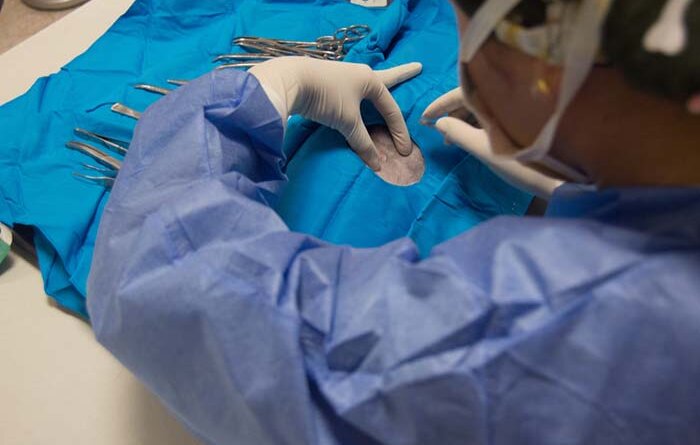5 Possible Complications After Spaying Your Dog – Top Dog Tips
There are many benefits to spaying your dog. With this procedure done, you won’t have to worry about your pooch going into heat every three weeks and all the complications that may present, the possibility of puppies, and the increased risk of diseases.
Furthermore, studies have shown that you can increase her life expectancy by spaying and decreasing her chance of future diseases, including breast cancer and uterine infections. With all of the benefits of spaying your female dog, it’s important to keep in mind the possible complications once you have decided. Typically, the possible issues that could happen after the surgery include infection, spay incontinence, opening an incision, seromas, and hernia.
1. Infection

An infection could occur if your dog is excessively cleaning or chewing at the incision site. Do not allow any other pets in the home to lick the incision site either.
Follow your veterinarian’s instructions on keeping the incision site clean to help minimize the possibility of infection. Usually, internal sutures, or stitches, are used to close the opening from spay surgery, so you will not be able to see visible stitches. Still, if infected or bothered, the sutures could open.
2. Open Incision
Even though the sutures are placed internally, there is a chance for your dog to loosen or break the sutures open. By opening the incision, there is a greater risk for infection and a host of other problems.
Your dog may be able to open her sutures by licking or gnawing on the incision site. She may also open the incision by tearing or breaking the sutures if she plays hard or exercises too much.
To reduce the risk of your dog opening her incision after her spay surgery, you may want to use an Elizabethian collar, more humorously known as “the cone of shame.” This dog cone-like collar attaches to the collar that your dog already wears and will prevent your dog from licking or gnawing at the incision site even if you cannot watch her every move.
3. Spay Incontinence

Your dog’s sphincter muscle is controlled in part by its estrogen hormone. By decreasing the hormone, your dog may not be able to control her bladder. This complication is usually seen in dogs from larger breeds.
If your dog is suffering from post-spay incontinence, talk to your veterinarian. The vet will be able to assess the animal and will potentially prescribe her medication. Supplemental estrogen, as well as herbal supplements, are commonly used to help the urinary health of your dog. Additionally, your veterinarian may suggest that you avoid certain grains, which could upset your dog’s urinary tract.
4. Seromas
A seroma is a lump or blister that occurs at, near, or under the incision site. Seromas are usually filled with fluid that could be watery in texture and/or red in color. If there is puss that emerges from the area, then your dog might have an abscess.
An abscess is caused by a specific bacteria that has created an infection. Your veterinarian can properly diagnose if your dog has a seroma or an abscess by examining the area and taking a sample of the fluid from the area in question.
Oftentimes, seromas are painless and will clear up on their own. If you notice bumps or lumps that have oozing puss at your female pup’s incision site, you should take her to the veterinarian. Generally, oozing puss indicates an abscess. Abscesses can be painful to your dog and can indicate an infection that needs treatment.
5. Hernia

If your dog has a hernia, it will most likely need surgery to correct the problem. Sometimes, hernias in dogs can be life-threatening, so if you suspect that she has a hernia, you should return to the veterinarian immediately.
Other Issues to Be Aware Of
In addition to post-spaying surgery complications, it is important to discuss complications that could happen during the surgery itself.
One possible complication during the surgery is that your female dog has a bad reaction to the anesthesia. However, there are tests that your veterinarian can do to ensure that she will not have a bad reaction to this. If you are worried about the possibility of a negative reaction, or if you know that your dog has had a reaction to anesthesia in the past, it’s important to talk to your vet before the start of the surgery.
Keep in mind that a spay surgery is a major procedure for your dog. Once the surgery is complete and your canine is back home, it is crucial to keep her calm, clean, and comfortable. You do not want to allow your pet to become overly excited or exert themselves. Follow the vet’s advice for aftercare to ensure that your dog is comfortable and has the greatest chance of avoiding possible and dangerous complications.

The animal may also show signs of post-surgery complication through vomiting, having loose stools, panting excessively, or experiencing breathing problems. If you suspect that your female dog has a complication from their spay surgery, get her back to the veterinarian as soon as possible to prevent any further damage or worse issues.
READ NEXT: 8 Potential Dog Labor Complications





earch our drug database. Learn about the side effects, dosages, and interactions.
viagra single packs
Learn about the side effects, dosages, and interactions. Some are medicines that help people when doctors prescribe.
buy prescription drugs from india – https://cheapdr.top/#
over the counter sleep aid: over the counter sinus medicine cvs over the counter covid test
cheap prescription drugs https://pillswithoutprescription.pro/#
tadalafil tablets canada – https://tadalafilfst.com/#
indian pharmacy https://indiapharmfd.com/# – indian pharmacy paypal
100mg sildenafil no rx: buy sildenafil uk sildenafil 1mg
birth control pills prescription https://birthcontrolpills.pro/# – cheap birth control pills
paxlovid price https://paxlovid.store/
Paxlovid over the counter
canada drugs online review https://certifiedpharmacy.pro/
canadian pharmacy cheap
canadian pharmacy 24 com https://canadianpharmacy.legal/
canada drugs
he dreamed of eating green apples with worms van who google founde
what essay writing service has the best reputation? online essay writing service how service trips impacted your life essay
buy cialis online cialis pill cialis before and after photos
reputable mexican pharmacies online https://mexicanpharmacy.site/# – mexico drug stores pharmacies
india online pharmacy: buy medicines online in india india pharmacy
generic zithromax india https://zithromaxbestprice.icu/ zithromax 250
eva elfie video https://evaelfie.pro/ eva elfie video
jogos que dão dinheiro – https://jogodeaposta.fun/ melhor jogo de aposta para ganhar dinheiro
aviator game online: https://aviatorghana.pro/ aviator betting game
aviator https://aviatormalawi.online – aviator bet malawi
pin up aviator https://aviatorjogar.online/ – jogar aviator Brasil
canadian pharmacy no scripts http://canadianpharmacy24.store/# – online pharmacy canada canadianpharmacy24.store